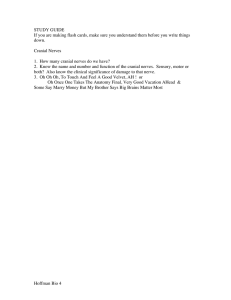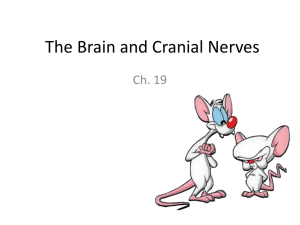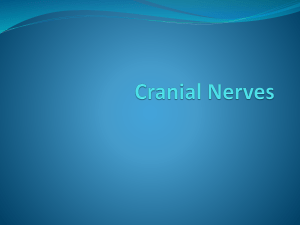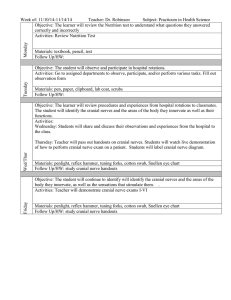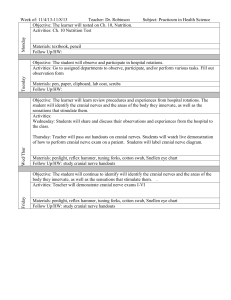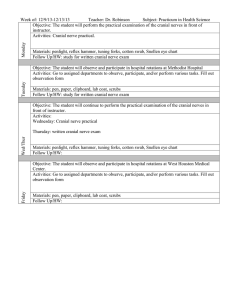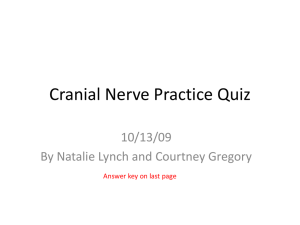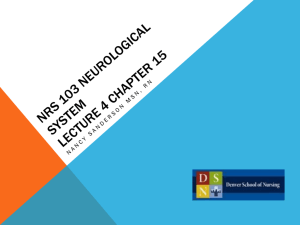The 12 Cranial Nerves - Moebius Syndrome Foundation
advertisement
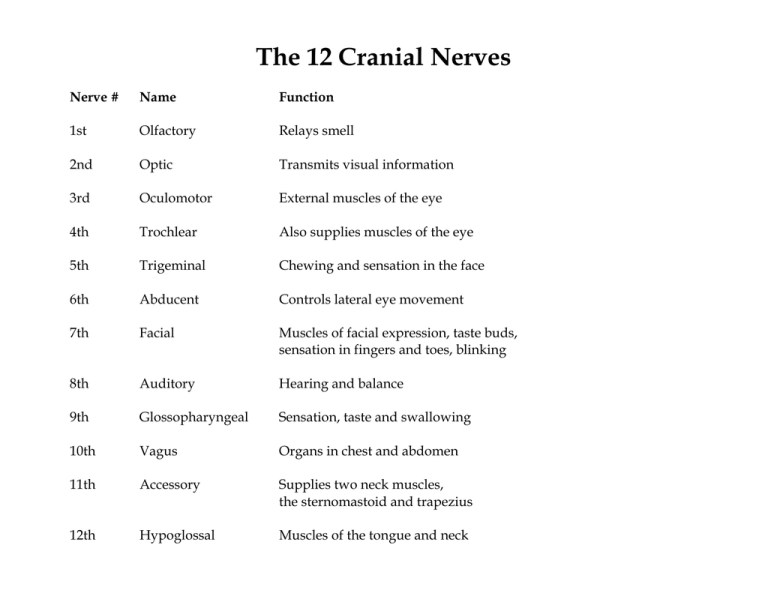
The 12 Cranial Nerves Nerve # Name Function 1st Olfactory Relays smell 2nd Optic Transmits visual information 3rd Oculomotor External muscles of the eye 4th Trochlear Also supplies muscles of the eye 5th Trigeminal Chewing and sensation in the face 6th Abducent Controls lateral eye movement 7th Facial Muscles of facial expression, taste buds, sensation in fingers and toes, blinking 8th Auditory Hearing and balance 9th Glossopharyngeal Sensation, taste and swallowing 10th Vagus Organs in chest and abdomen 11th Accessory Supplies two neck muscles, the sternomastoid and trapezius 12th Hypoglossal Muscles of the tongue and neck The 12 Cranial Nerves—Detail Cranial Nerve 1 Sensory nerve – Olfactory Nerve – controls sense of smell Cranial Nerve 2 Sensory nerve- Optic Nerve- controls vision by sending information from retina Cranial Nerve 3 Motor nerve- Oculomotor Nerve-Controls most eye muscles. Works closely with Cranial Nerves 4 & 6. Controls eye movement, pupil dilation, and pupillary constriction. It also controls the muscles that elevate the upper eyelids. Cranial Nerve 4 Motor nerve- Trochlear Nerve- Controls the downward and outward movement of the eye. Works closely with Cranial Nerves 3 & 6. Can cause vertical Diplopia (double vision). Weakness of downward gaze can cause difficulty in descending stairs. Cranial Nerve 5 Motor and sensory nerve-Trigeminal Nerve-Carries sensory information from most of the head, neck, sinuses, and face. Also carries sensory information for ear and tympanic membrane. Provides motor supply to the muscles of masticulation (chewing), and to some of the muscles on the floor of the mouth. Also provides motor supply to tensor tympani (small muscle in the middle ear which tenses to protect the eardrum). Cranial Nerve 6 Motor nerve-Abducens Nerve- Controls the outward movement of the eye. Cranial Nerve 7 Sensory and motor nerve-Facial Nerve- Supplies the muscles of facial expression. Supplies posterior belly of digastric muscle (small muscle on underside of jaw). Supplies Stylohyoid muscle (used in swallowing). Supplies stapedius muscle (middle ear). Controls taste sensations from the anterior 2/3 of the tongue. Cranial Nerve 8 Sensory nerve- Vestibulocochlear Nerve- controls hearing and balance. Vestibular nerve receives positional information. Cochlear nerve transmits information on sound to the brain. Cranial Nerve 9 Sensory and motor nerve-Glossopharyneal Nerve- controls some muscles used in swallowing including movement and sensation of throat, nasal passages and tongue. Controls taste from the posterior one third of tongue. Cranial Nerve 10 Sensory and motor nerve- Vagus Nerve- controls muscles of the pharynx and larynx. Processes sensory information from external ear, pharynx, larynx and viscera. Serves the throat, nasal passages, heart lungs and stomach. Cranial Nerve 11 Motor nerve-Spinal/Accessory-controls muscles used in head and shoulder movement. Cranial Nerve 12 Motor nerve-Hypoglossal Nerve-controls muscles of the tongue. Can cause speech problems, ipsilateral (single sided) movement of the tongue and thick speech. Compiled by Jennifer Garbuzinski Remembering the 12 Cranial Nerves, from the MCC Paramedic Program Acronym Cranial Nerve Roman Numeral ON Olfactory I OLD Optic II OLYMPUS Oculomotor III TINY Trochlear IV TOPS Trigeminal V A Abducens VI FIN Facial VII AND Auditory VIII GERMAN Glossal-pharyngeal IX VIEWED Vagus X SOME Spinal accessary XI HOPS Hypopharyngeal XII Motor Sensory Both Function SOME SAY MARRY MONEY BUT MY BROTHER SAYS BAD BUSINESS MARRY MONEY Smell Vision (retinal) Pupil constr/Eye mvmnt Eye mvmnt Sensory face, mastication Eye mvmnt Face motor, taste ant. 2/3 Hearing gag sense, swallowing Parasympathetic, cough Shrug shoulders Tongue protrusion Presented by Diane Breton at the 1st Moebius Syndrome Conference in Los Angeles in 1994 (courtesy of http://www.monroecc.edu/depts/pstc/paracnvs.htm)
